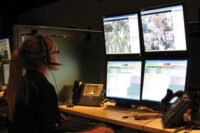Advances in surveillance video equipment and widespread availability of broadband connectivity such as DSL and cable modems have made possible a range of video monitoring options. How do these options impact a dealer’s operations? What is required to support them? How should they be priced? And how profitable are they?
Because video monitoring is still an emerging business opportunity, some security dealers and platform providers are reluctant to share details about pricing and margins, but most of those interviewed for this article were willing to discuss the subject in broad terms about pricing structure and profitability.
Video Verification
One of the most common forms of video monitoring is video verification. With this service, a clip from a surveillance video camera is sent to the central station when triggered either by internal motion detection built into the camera or through a trigger from an alarm system — such as when someone opens a protected door. Having the video image helps the central station operator determine whether an intruder is present or whether the event was triggered by some other cause such as an animal.
A security dealer might charge as little as $5 or $10 a month for video verification, says Bill Bozeman, CEO and president of the PSA Security Network integrator group. Bozeman says he has even seen dealers offer video verification at no extra charge as part of regular monthly alarm monitoring, perhaps in the belief that it will enhance account loyalty.
If multiple cameras are involved, dealers may charge accounts on a per-camera basis for video verification. Some third-party central stations, including San Antonio, Texas-based United Central Control, charge dealers for video verification on a per-camera basis and dealers using those central stations are likely to follow that same approach in structuring costs for their end users.
Dealer margins for video monitoring services in general are lower than for traditional alarm monitoring, notes UCC senior vice president Mark Matlock. But often video verification is an add-on to traditional alarm monitoring, raising the total amount of revenue that the dealer takes in per account. Matlock adds that UCC doesn’t take accounts for video-verification only. The service must be sold in combination with traditional alarm monitoring. UCC also charges more for video verification if a camera is located outdoors because the central station experiences a higher activation rate for outdoor cameras than for indoor ones.
Dealers that operate their own central stations will need to figure in the extra costs required to support video verification. At the outset, the dealer will need to purchase and install a software package, preferably one that can integrate with the company’s central station automation system. The ability to store video clips for the customer also is a useful feature, particularly for customers that do not have on-site storage. It’s also important for dealers to recognize that the number of events that an individual operator can handle will decrease when video verification is added and that ongoing training requirements will increase, which means ongoing operating costs also will increase.
Matthew Ladd, president of Exton, Pa.-based The Protection Bureau, SDM’s 2010 Dealer of the Year, notes that if a central station only handles traditional alarm signals, it typically needs to add a new operator whenever the company’s total number of monitored accounts increases by about 3,000 or 4,000. But if the central station also supports video monitoring, it will need to add new operators before the 3,000-new-customer-level is reached.
Some central stations use the same basic technology underlying video verification to enable other video monitoring services. Naperville, Ill.-based Stanley Convergent Security Solutions, for example, offers an open-and-close-with-video service that automatically records images of the system user whenever a system is armed or disarmed. Customers pay for the service based on the amount of activity their system typically generates on a monthly basis, explains Felix Gonzales, vice president of strategic initiatives for Stanley CSS.
The best image quality will be obtained when video verification and related services are based on a broadband connection to an IP camera or digital video recorder at the customer site. But the cost of that type of solution may be too high for some residential users. As an alternative, White Bear Lake, Minn.-based Videofied offers a camera with internal motion detection designed especially for video verification that automatically sends images over a traditional phone line or cellular phone connection to the central station. As Gonzales explains, Stanley’s central station supports Videofied systems, adding value by recording the clips sent to the central station and by automatically sending an e-mail to an account when an alarm occurs using what the company calls its “eServices” platform. When customers get an e-mail, they can log in to a secured website to view the associated video clip.
Stanley CSS made a substantial investment to establish the platform that supports “eServices.” But as an alternative, dealers can resell a service from a third-party supplier that provides similar functionality. New York, N.Y.-based Xanboo, for example, offers a service that automatically alerts customers of alarms and lets them view video clips associated with those alarms.
Interactive Video
Bozeman uses the term “interactive video” to describe the next level of video monitoring options. With interactive video options, a central station operator essentially looks in on the cameras at a customer’s site in real-time — a capability that facilitates a range of video monitoring services.
One example is an escort service that that lets a central station operator watch a customer’s employee get to his or her car — a capability that dealers typically charge for based on the number of escorts a customer normally needs per month.
Another example of an interactive video monitoring service goes by a variety of names. The Protection Bureau calls it “content analysis,” while Stanley calls it eVideo Audit. These services are often used by retailers with multiple locations, enabling them to use central station personnel to make sure all locations are complying with requirements specified by the customer, such as making sure employees are wearing uniforms and that signage is displayed properly. Such services may be available on demand. For example, Ladd says, a realtor might ask central station operators to check on a property shortly before any potential buyers are scheduled to tour it. Both The Protection Bureau and Stanley charge for these services based on the number of times they are used per month.
One of the most popular interactive video monitoring services, sources interviewed for this story agree, is the video guard tour. This service enables customers to minimize or eliminate human guards, instead using central station personnel to look in on cameras around a customer’s site at specific intervals according to the customer’s specifications.
Pricing for guard replacement services is typically based on the number of cameras and number of tours per day. Revenues from such services can run into thousands of dollars per month per account, Bozeman notes. Yet this type of service is one of the easiest for customers to cost-justify because the cost of around-the-clock guard service can run approximately $170,000 per year. Other interactive video services do not generate quite so much revenue, but nevertheless can range from $100 to as much as nearly $1,000 per customer per month, Bozeman says. Margins for interactive video monitoring services, Bozeman says, can be in the 30 percent to 50 percent range.
It’s important to recognize, though, that the investment that an individual central station must make to support interactive video services is substantial. The investment runs in the millions of dollars, putting it out of reach of all but the largest security dealers, notes Sharon Shaw, vice president of integrator support for Integrator Support, an organization that provides video monitoring services to PSA Security Network members.
Ongoing costs for interactive video monitoring services also are substantial. “What we’re finding is that an operator doing heavy guard tours only may be able to handle eight to 10 customers per shift,” Ladd notes — and customers often request guard tours after normal business hours.
As central stations begin to support services such as guard tours and video escort, they also should strongly consider storing any video associated with those services, Gonzales advises. “We want an audit trail,” he says. “We want to know when the operator looks in. Every second they’re viewing, we record it into our database.” If a central station chooses to routinely record numerous video events, however, they also will need to figure in the cost of storage resources in determining the business case for those services.
As an alternative to taking on the costs required to support interactive video monitoring, dealers may want to use a third-party provider for such services. Both Integrator Support and UCC, as well as many other central stations, now offer interactive video monitoring services such as guard tours on a wholesale basis.
Other interactive video monitoring services are triggered by specific events at the customer premises. For example, both Integrator Support and Stanley use voice capability as part of a service that automatically sends video to the central station when people enter a protected area. A central station operator then asks the people to leave. As Shaw explains, this type of service can minimize a business customer’s liability by, for example, helping to prevent teenagers from skateboarding on the customer’s property. A twist on this offering is a video concierge service that lets central station personnel remotely release doors controlled by the customer’s access control system.
Storage Services
Another category of video monitoring services involves off-site storage of images from customers’ video cameras. A key advantage of this type of offering is that it can eliminate the need for customers to purchase a DVR — particularly if the customer chooses a video camera with built-in storage as a backup in the event of a connectivity failure.
Chelmsford, Mass.-based IP video manufacturer Axis Communications is working with companies that operate large data centers to create an option that would let customers use one or more IP cameras in combination with a broadband connection to send video over the network to the data center for storage. Facilitating this offering is a capability that Axis Communications general manager Fredrik Nilsson calls “one-click discovery,” which enables the customer’s cameras to be easily connected to the data center. Without that capability, Nilsson said, highly trained information technology personnel would be required to establish smart scripts in customer routers to address potential issues involving firewalls.
“The bandwidth required for good quality streaming is about 100 to 200 kilobits per second per camera,” Nilsson explains. Those numbers suggest that a typical cable modem or DSL connection could easily support a few cameras. Typically a customer would use a low frame rate for continuous recording, automatically switching to a higher frame rate in the event of an alarm. Authorized users can remotely view stored images as needed, Nilsson says. Customers pay for the service based on the amount of storage needed per month, which in turn is determined by how long images are archived, the frame rate used and how many cameras are recorded.
Nilsson notes, however, that anyone wanting to offer video storage services “needs to realize the amount of investment that needs to go into it.” Because storage requirements can be significant, Axis has focused on data center operators that specialize in storage solutions as potential partners. Those partners would then resell the service to central stations.
Another company pursuing video storage opportunities is Woburn, Mass.-based OzVision, which offers a storage service that it resells through third-party central stations including UCC.
| Check-up Time |
| Video monitoring is only as good as the equipment at the customer site that underpins it. Recognizing that, Stanley Convergent Security Solutions offers a video monitoring option the company calls eVideo Support Services. Central station operators check a customer’s system on a daily basis to make sure it is operating properly. On a monthly or quarterly basis, the company also checks on each individual camera to make sure that cameras are properly aimed and images from each camera are clear. |
| A Menu of Video Monitoring Services |
|
The number and variety of video monitoring service options is diverse. The following is a list of nine of the most popular video monitoring services currently available — and undoubtedly there are others as well. The security industry has not yet developed standard terminology for all of these services; some dealers use their own brand names. • Archiving services. Off-site storage of images from customers’ video cameras. • Audit services. Check in on a business customer’s locations to ensure that locations are conforming to prescribed guidelines. Typically available on demand, these services also can be used by realtors to make sure properties are ready for a showing. • Concierge services. Incorporating two-way audio and access control as well as video monitoring, these services use central station personnel to perform tasks traditionally handled by doormen or receptionists. • E-mail alerts. Customer receives an e-mail if an alarm occurs and can go to a website to review a video clip associated with the alarm. • Guard tours. Central station operators look in on cameras around a customer’s location at specific intervals according to the customer’s specifications. • Video escort. Central station operators watch a customer’s employees to make sure they get safely to their vehicles. • Video monitoring plus voice down. In response to motion-detected events, central station personnel ask trespassers to leave. • Video verification. Central station operators review a clip associated with an alarm to help determine if an actual intrusion has occurred. |






